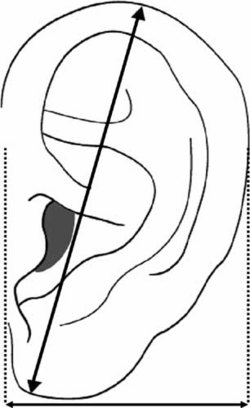Ear, Long
Definition:

Ear, Long
Objective: Median longitudinal ear length greater than two SD above the mean
Subjective: Apparently increased length of the ear
Comments: Ear length is determined by the maximal distance from the superior aspect to the inferior aspect of the external ear. Normal values are available from birth to 16 years of age [Feingold and Bossert, [1974]; Hall et al., [2007]] and birth to 18 years of age [Farkas, [1981]] specific for sex. Adult values for length and width, separated by sex, are published from a sample of US Army personnel (Tech Report NATICK/TR-89/027, pp 89-90) but these are difficult to obtain. Adult Japanese data are also available [Itoh et al., [2001]]. Both adult sets suggest ears increase in length into adulthood and ears in males are larger than those in females. Ears probably more often look large in relation to a small head than actually are large. For this reason we strongly support measurements in assessing ear length. Subjective assessments of ear length should only be used if unavoidable. We encourage recording ear width as well [Farkas, [1981]]. In fact, the commonly used term Macrotia is a bundled term comprising increased length and width (surface area).
COMMENTS (0) | Add Comment









